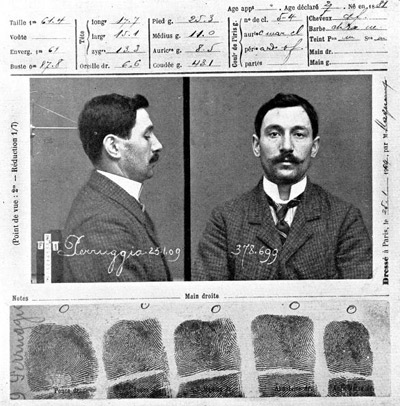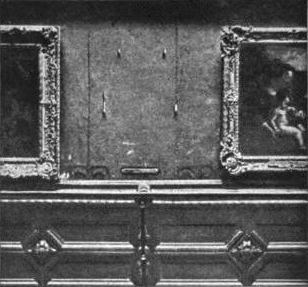JF Ptak Science Books Post 1921 [Part of the series on the History of Blank, Empty and Missing Things]
[See also the recent post on Mona Lisa's Missing Jewelry.]
In the category of upper-levels things gone missing (though not nearly in the same category as entire libraries that have been destroyed over time) is the theft of the Mona Lisa. This is an odd story full of detail and holes that could have been the work of one man, Vincent Peruggia (born in 1881 and pictured above in his mugshot) and who with extreme naviete thought he could steal the painting and sell it to the Uffizi and regain the prestige of Italy over its own missing masterpiece by a native son. It also could have been the work of a thief/forger team of Marque Eduardo de Valfierno and Yes Chaudron who set Peruggia to the task of stealing the painting, with Valfierno contracting the sale of as many as six Mona Lisa forgeries to interested parties.
Valfierno's idea was pretty cunning and diabolical--his only need was to have the real Mona Lisa disappear; then he could have his accomplice forger produce x-number of copies and sell them to x-number of collectors as the real thing. After all, its not as though Mona Lisa owners would have a convention, so the ownership of the world's most famous and stolen painting would be a very private affair. Also any claim of the real Mona Lisa appearing anywhere else--even restored to its place in the Louvre--would simply be met by the assertion by Valfierno that those "other" Mona Lisas were forgery. So it was forgeries all the way around.
 And so Peruggia--an itinerant laborer who made his way to Paris for a better life and who had been working as a carpenter there at the Louvre--stole the painting on 22 August 1911. A Monday, it was, when the Louvre was closed to the public for staff to make repairs and such. Evidently he simply worked his way over to the painting, took it off the wall, got a quiet place and removed it from the big frame (and glass!, which was a new security innovation to protect treasures from crank marauders), and loaded the Mona Lisa under his work smock. (He got the painting out of the building by getting a guard to unlock a door for him--one from which he had previously removed the doorknob, blaming its absence on scofflaws, distracting the man with the key enough to just open the door for Peruggia.)
And so Peruggia--an itinerant laborer who made his way to Paris for a better life and who had been working as a carpenter there at the Louvre--stole the painting on 22 August 1911. A Monday, it was, when the Louvre was closed to the public for staff to make repairs and such. Evidently he simply worked his way over to the painting, took it off the wall, got a quiet place and removed it from the big frame (and glass!, which was a new security innovation to protect treasures from crank marauders), and loaded the Mona Lisa under his work smock. (He got the painting out of the building by getting a guard to unlock a door for him--one from which he had previously removed the doorknob, blaming its absence on scofflaws, distracting the man with the key enough to just open the door for Peruggia.)
The blank/missing hanging space of the Mona Lisa at the Louvre in the Gallerie Carre was a vivid testament to the power of the painting, with thousands of people trudging by the depressing art-hole to stare at its absence. There were just four iron hooks on the wall, waiting for it, pounded into the plaster between Correggio's Mystical Marriage of St. Catherine and Titian's Allegory of Alfonso d'Avalos.
Once Peruggia had completed the theft he was no longer needed. If Valfierno had actually been involved he would simply have used Peruggia as a fall guy, the many who made the sale of the forgeries possible. Peruggia wound up living in a series of shabby places, working his way back to Italy, perhaps waiting for further instructions, perhaps just a solo agent making his way back home.
If he was an accomplice in a more involved scheme, one could only imagine his frustration in being abandoned--there he was, sleeping on a cot in top of a box filled with his clothing and the Mona Lisa, waiting for something to happen that wouldn't.
Peruggia found his way back to Florence, staying in Room 20 of the third floor of the Hotel Tripoli Italia on Via Panzoni, which was only hundreds of feet away from where Leonardo had once painted the Mona Lisa. In 1913 he finally contacted officials at the Uffizi in a very weird and awkward attempt to sell it to the museum. He was of course apprehended almost immediately, the museum guardians retrieving the painting from beneath Peruggia's socks and underwear in the box under his bed.After being exhibited in Italy to tens of thousands of viewers, the Mona Lisa was returned to Paris on 4 January 1914.
Peruggia was evidently quite open about his theft but didn't have anything to say about accomplices. He was sentenced to a little more than a year for his crime--a sentence very soon after reduced to seven months. Following honorable service in WWI, Peruggia wound up in a suburb of Paris with a family and a hardware store, where he died of a heart attack in 1925. When returned to his hometown following his brief incarceration, he was welcomed as a hero--he may have been more so if he hadn't demanded a payment for the painting.



Comments